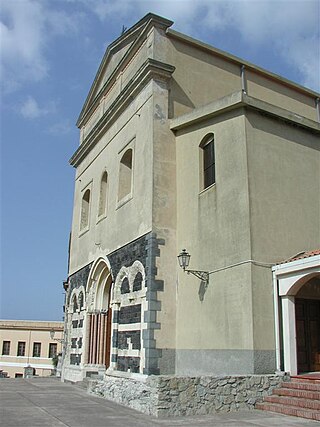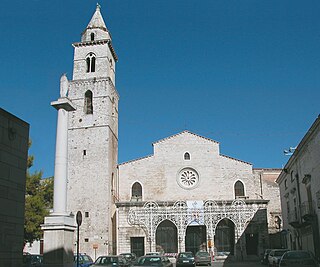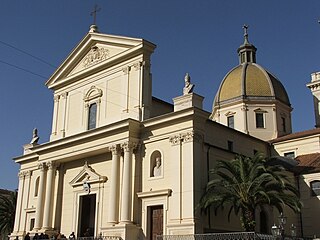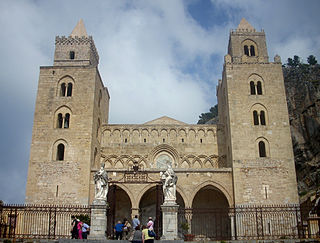
The Roman Catholic Diocese of Patti is located on the north shore of the island of Sicily. It is a suffragan of the Archdiocese of Messina-Lipari-Santa Lucia del Mela. Its patron saint is Bartholomew the Apostle, in whose honor the cathedral is named.

The Roman Catholic Metropolitan Archdiocese of Palermo was founded as the Diocese of Palermo in the first century and raised to the status of archdiocese in the 11th century. The archbishop is Corrado Lorefice.

The Diocese of Cassano all'Jonio is a Roman Catholic diocese in Calabria.

The Archdiocese of Messina was founded as the Diocese of Messina but was raised to the level of an archdiocese on 30 September 1986 with the merging with the former Diocese of Lipari and the Territorial Prelature of Santa Lucia del Mela (1206), and as suffragans the Diocese of Patti and Diocese of Nicosia.

The Diocese of Nocera Umbra was a Roman Catholic diocese in Umbria, Italy.

The Catholic Diocese of Avellino is in the territory of the Irpini, some 55 km (30 mi) east of Naples and 23 km (14 mi) south of Benevento, in the modern Republic of Italy. It is suffragan to the archdiocese of Benevento. The bishop of Avellino, along with the bishop of S. Agata de' Goti, had the privilege, recognized at the provincial synod of 1654, of being summoned to attend upon the death and obsequies of the archbishop of Benevento.

The Italian Catholic Diocese of Mazara del Vallo is in far western Sicily. It is a suffragan of the Archdiocese of Palermo.

The Archdiocese of Siracusa, also known as Syracuse, is a Latin Church ecclesiastical territory or diocese of the Catholic Church in Sicily. It became an archdiocese in 1844. The current archbishop is Francesco Lomanto.

The Archdiocese of Catania is a Roman Catholic ecclesiastic territory in Sicily, southern Italy, with its seat in Catania. It was elevated to an archdiocese in 1859, and became a metropolitan see in 2000. Its suffragans are the diocese of Acireale and the diocese of Caltagirone.

The Italian Roman Catholic diocese of Conversano-Monopoli, in Apulia, has existed since 1986, when the diocese of Monopoli was united with the historic diocese of Conversano. The diocese is a suffragan of the Archdiocese of Bari-Bitonto.

The Italian Catholic Diocese of San Severo is in Apulia. It is a suffragan of the Archdiocese of Foggia-Bovino.

The Italian Catholic Diocese of Ugento-Santa Maria di Leuca in Apulia, has existed under this name since 1959. It is a suffragan of the Archdiocese of Lecce. The historic Diocese of Ugento has existed since the thirteenth century.

The Diocese of Caserta is a Roman Catholic ecclesiastical territory in Campania, southern Italy. It is a suffragan of the Archdiocese of Naples. In 1818 Pope Pius VII united this see with the diocese of Caiazzo, but Pope Pius IX made them separate sees. In 2013 in the diocese of Caserta there was one priest for every 1,703 Catholics; in 2016, there was one priest for every 2,008 Catholics. The diocesan Major Seminary currently (2019) has four seminarians.

The Italian Catholic diocese of Andria is in Apulia, seated at Andria Cathedral which is built over a church dedicated to St. Peter, about ten miles southwest of Trani. It is a suffragan of the archdiocese of Bari-Bitonto. The diocese has 39 parishes, with one priest for every 1,573 Catholics.

The Diocese of Sessa Aurunca is a Roman Catholic ecclesiastical territory in southern Italy. Since 1979 it has been a suffragan of the Archdiocese of Naples.

The Italian Catholic Diocese of Lamezia Terme is in Calabria. In 1818 the ancient see of Martirano, the former Mamertum, was united to the diocese of Nicastro. The diocese was then a suffragan of the archdiocese of Reggio in Calabria. In 1986, the historic Diocese of Nicastro had its name changed. It is currently called the Diocese of Lamezia Terme, and it is a suffragan of the Archdiocese of Catanzaro-Squillace. The name change reflects the incorporation of the comune of Nicastro into Lamezia Terme, an administrative change of 1968 on the part of the State of Italy.

The Italian Catholic Archdiocese of Monreale is in Sicily. As of 2000 it is no longer a metropolitan see, and is now a suffragan of the Archdiocese of Palermo.

The Diocese of Cefalù is a Roman Catholic ecclesiastical territory in Sicily, southern Italy. It is a suffragan of the Archdiocese of Palermo.
The Italian Catholic diocese of Lacedonia, a suffragan of the archdiocese of Benevento in Campania, existed until 1986 when incorporated into the reorganized Roman Catholic Diocese of Ariano Irpino-Lacedonia.

The Roman Catholic Diocese of Lipari was a Latin diocese of the Roman Catholic Church located in the town of Lipari in the Aeolian Islands of Sicily, Italy. The diocese consists of the entire island of Lipari as well as seven smaller adjacent islands. It is now incorporated into the Archdiocese of Messina-Lipari-Santa Lucia del Mela.





















